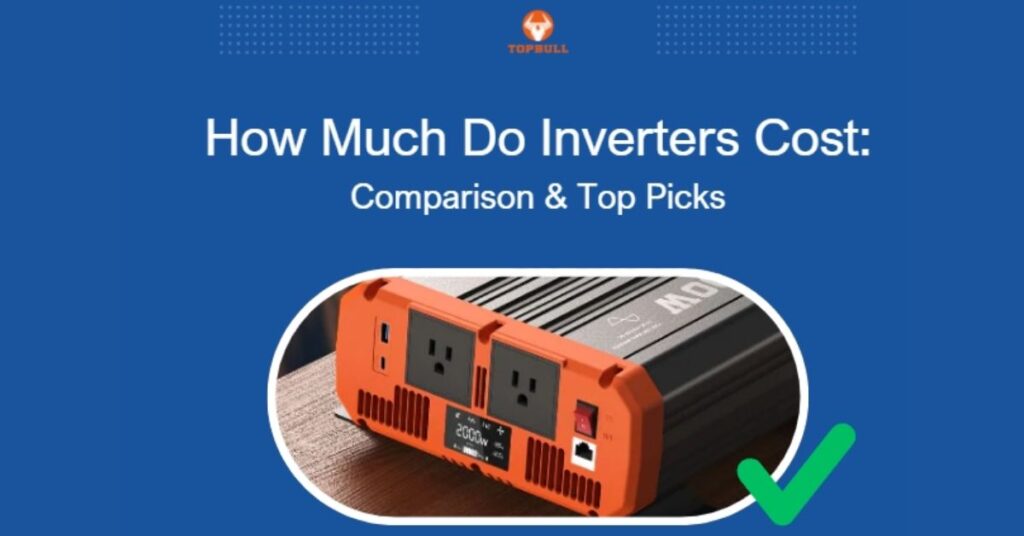When picking a power inverter, it’s common that many of you are puzzled by the prices of power inverters: What makes some inverters more valuable than others? Why are there cheap and expensive power inverters, and how do you choose a decent one?
In this post, we’ll explore the basics of power inverters, uncover the price ranges, and offer the best power inverters for both best value and premium options. We’ll also guide you through key factors to consider when selecting an inverter and address common FAQs about their costs. Let’s dive in to find the perfect inverter for your needs!
What are power inverters?
A power inverter converts direct current (DC) from batteries or solar panels into alternating current (AC), the standard electricity used by household appliances and electronics. By transforming stored energy into usable power, power inverters enable you to run devices like laptops, lights, or refrigerators off-grid, in vehicles, or during outages. They’re essential for camping, RV travel, emergency backup systems, or renewable energy setups.
Pure Sine Wave Inverters vs Modified Sine Wave Inverters: Which to Choose
When choosing an inverter, there are 2 common types: pure sine wave inverters and modified ones. Pure sine wave inverters produce smooth, grid-like electricity, ideal for sensitive electronics (e.g., laptops and microwaves). Modified sine wave models are cheaper but generate a stepped waveform, which may cause humming in motors or damage to delicate equipment.
Therefore, pure sine wave inverters are more recommended for versatility and safety.
What are the prices of inverters?
Navigating inverter pricing can be tricky, as costs vary widely based on specifications, quality, and intended use. Whether you’re powering a weekend camping trip or backing up a home solar system, understanding price ranges and value drivers ensures you invest wisely.
Pure Sine Wave Inverters typically command premium pricing due to their advanced circuitry and compatibility with sensitive electronics. For example:
- Low power (300–1000W): $100–$100–$400
- Mid-range (2000–3000W): $300–$300–$1,000
- High power (5000W+): $1,200–$1,200–$3,500+
Modified Sine Wave Inverters are far more affordable but limited to basic appliances like lights or tools:
- Low power (300–1000W): $50–$50–$150
- Mid-range (2000–3000W): $150–$150–$500
What heavily affects the prices of power inverters?
The cost of a power inverter is driven by several key factors.
- Higher wattage models require heavy-duty components, leading to exponential price increases—doubling power can quadruple costs.
- Waveform quality is pivotal: pure sine wave inverters, essential for sensitive electronics, cost 50–100% more than modified sine wave versions.
- Efficiency above 90% demands advanced circuitry, raising prices but cutting long-term energy loss.
- Built-in protections (overload, short-circuit) and certifications (UL, CE) add safety assurances but hike production expenses.
- Brand reputation also matters, as established names charge premiums for proven reliability. For example, choose power inverters from the best power inverter brand like Topbull. Reputable brands invest in rigorous testing, high-quality components (e.g., durable capacitors, pure sine wave circuitry), and certifications (UL, CE) to meet safety standards, reducing risks of overheating or electrical hazards.
- Smart features like Wi-Fi monitoring or hybrid compatibility integrate complex tech, further elevating costs. Balancing these elements ensures you invest in a durable, purpose-built inverter without overspending.
Recommendations: Best Value & Premium Inverters
Now that you understand the average prices of power inverters, let’s explore ideal options for different needs:
2000W Power Inverters for Basic Needs
For basic off-grid use (e.g., camping, RVs, or powering small appliances like microwaves or TVs), a 2000W pure sine wave inverter strikes a balance between affordability and capability. It efficiently supports sensitive electronics and compact setups without overwhelming your battery.
3000W-4000W Power Inverters for Relatively High Devices
If you need to power larger systems (e.g., whole-house backup, heavy-duty tools, or multiple high-watt devices like air conditioners), opt for a 3000W–4000W pure sine wave inverter. These models handle higher loads seamlessly, ensuring stable energy for demanding scenarios while protecting advanced equipment.
Always match the inverter’s capacity to your peak power requirements and prioritize pure sine wave technology for reliability.
How do you find a decent inverter: Factors to Consider
Choosing the right power inverter can feel overwhelming with endless specs and brands. To simplify your search, focus on these non-negotiable features for safety, efficiency, and long-term value.
- Prioritize pure sine wave inverters. They mimic grid-quality electricity, ensuring compatibility with sensitive devices (e.g., laptops, medical equipment) and preventing motor hum or damage.
- Match the output power to your needs: calculate both the continuous and peak wattage of your appliances to avoid under- or overloading.
- Aim for conversion efficiency above 85% to minimize energy loss, especially for solar or battery-dependent setups.
- Comprehensive protections (overload, short-circuit, overheating) are critical to safeguard both the inverter and connected devices.
Finally, stick to reputable brands and read verified customer reviews to gauge real-world reliability. A well-researched inverter is an investment, not just a purchase.
What are the differences between cheap and expensive power inverters?
Budget inverters often cut corners with lower-grade components (e.g., fragile capacitors, thin wiring), risking overheating or premature failure. They typically use modified sine wave output, which may damage sensitive electronics like laptops or medical devices. Cheap models also skimp on protections (no surge/overload safeguards) and efficiency (80–85%), wasting energy.
In contrast, premium inverters prioritize pure sine wave output, high-efficiency designs (90–95%), and robust protections (thermal shutdown, short-circuit prevention). They feature durable builds and certifications (UL, CE) for safety. Expensive models may include smart features (app control, solar compatibility) and reputable brand warranties. While costly upfront, they ensure reliability, safety, and long-term savings, which is ideal for critical or heavy-duty use.
Wrap Up
Choosing the right power inverter boils down to balancing your budget with performance needs and long-term reliability. While pure sine wave models cost more upfront, their compatibility with sensitive electronics and robust safety features often justifies the investment. Modified sine wave inverters offer a budget-friendly alternative for basic, short-term use but come with limits.
Always factor in wattage requirements, efficiency ratings, and certifications to avoid overspending or compromising on quality. Remember: a well-chosen inverter isn’t just a purchase. It’s a safeguard for your devices and a cornerstone of energy independence.







